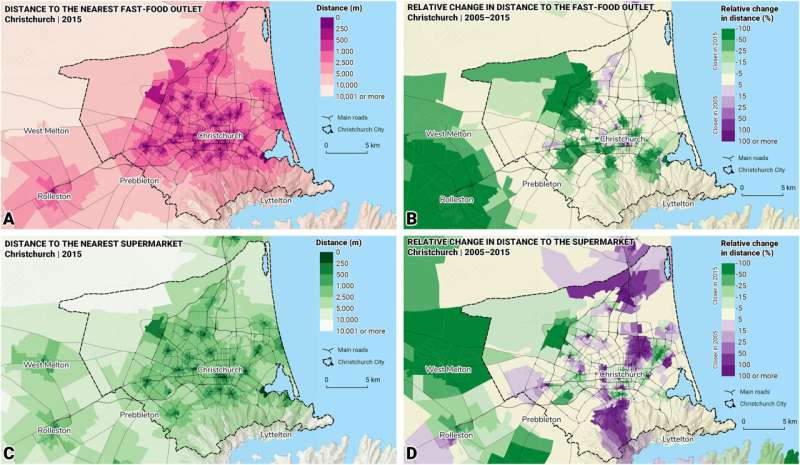
Living close to fast-food outlets may be bad for your waistline, while living closer to a supermarket may be slightly better for your health, a new University of Canterbury study suggests.
Working with the Christchurch Health and Development Study (CHDS) birth cohort, Te Whare Wānanga o Waitaha | University of Canterbury (UC) Public Health Senior Lecturer and Co-Director of the GeoHealth Laboratory, Dr. Matthew Hobbs and team investigated impacts on health around change in access to both fast food and supermarkets. He says the findings are important for population health.
“We know that fast-food vendors locate in more deprived areas, and we know that more deprived areas have a higher prevalence of people living with obesity. We are hoping we can use this evidence to advocate for healthier food environments,” Dr. Hobbs says.
Relative to those who lived further away, people closer or with better access to supermarkets had the smallest increases in body mass index (BMI) and waist circumference (WC), the study found. The results are published in the journal Health & Place.
“A global rise in obesity since 1980 is too rapid for genetic or biological factors to be the root cause. While individual risk factors such as genetic makeup explain some differences between individuals, it was reasonable to suggest the rise in obesity seems to be fueled by the coincidental increased supply of cheap, palatable, energy-dense foods that are accessible, convenient, and effectively marketed,” Dr. Hobbs says.
The CHDS is a birth cohort study using a group of people born in 1977, with data collected until they turned 40 in 2017.
“Living with obesity is known to lessen life expectancy markedly and what happens during early- to mid-adulthood has profound and long-lasting implications for future health. We looked at details about each person’s change in BMI and waist circumference from age 30 to age 40 years. We wanted to know how a change in people’s ‘food environments’—either changing residential address, or a new fast-food outlet or supermarket moving closer to where people live—would affect waistlines.”
The study found evidence that people who lived closer to fast-food outlets over the ten-year period had slightly larger increases in BMI and waistlines.
This study only measured change in geographic access to food outlets and did not look at other important aspects of the food environment including for example price, quality or actual use of facilities.
“Recent U.K. documentation shows around half of the country’s local government areas had a policy specifically regulating proliferation of fast-food outlets through urban planning using such means. I guess the key ‘takeaway’ is that public health authorities and planners should be giving some serious thought to where fast-food outlets and supermarkets can be located to improve population health,” he says.
More information:
Matthew Hobbs et al, Change in the food environment and measured adiposity in adulthood in the Christchurch Health and development birth cohort, Aotearoa, New Zealand: A birth cohort study, Health & Place (2023). DOI: 10.1016/j.healthplace.2023.103078
Journal information:
Health & Place
Source: Read Full Article





